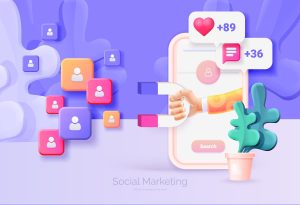Leveraging Motion for Engaging Experiences
The days of static, boring websites are over. As San Diego’s premier digital marketing agency, Now Media Group creates websites that feel more fluid, engaging, and interactive thanks to our creative use of motion in web design. Animation and motion elements bring websites to life in an eye-catching way while enhancing the user experience. Effective motion usage makes websites more intuitive, conveys branding exceptionally well, and keeps visitors interested.
Web design has increasingly incorporated motion for functional and aesthetic purposes. Subtle or dramatic animations guide users, communicate information more effectively and add an element of delight. From meaningful page transitions to animated illustrations, motion contributes greatly to the modern web experience crafted by our digital strategists.
Now Media Group leverages the power of purposeful motion to boost brand recognition and create satisfying user experiences. Call Now Media Group today at (858) 333-8950 to learn how we can energize your website with animated elements tailored to your brand.
Web Design’s Background
Early websites consisted mainly of static pages with text and images only. There was little dynamic content or visual excitement beyond some simple flashing graphics or text. As web technologies advanced, animations through CSS, JavaScript, HTML5, and various frameworks became more sophisticated.
Today’s faster broadband speeds allow for website animation and motion that don’t detract from site performance. Used strategically, motion improves websites and complements their purpose rather than acting as a decorative element. It enhances branding, storytelling, and the user experience.
Types of Motion in Web Design
Meaningful Transitions
When designed effectively, motion guides users through the site intuitively. Page transitions or animated swipes can indicate navigation paths. Transitions can focus attention, clearly signaling the arrival of new content. Similarly, subtle animation can direct attention to calls to action (CTA).
Microinteractions
These are isolated animations tied to a single action, such as hovering over an element or clicking a button. Examples include loading indicators, notifications, switch toggles, and animated menus. These motions provide users feedback, such as confirmation of an action. The animations add dynamism and personality to interactions.
Scroll-based Animations
Scroll-triggered animations use the scroll position to determine animation timing and effects. Parallax backgrounds that respond to scrolling or elements that slide, fade, or scale-dynamically based on scroll progress guide visitor attention down the page. This reveals bite-sized content while maintaining interest.
Interactive Animations
User input like hovering, clicking, dragging, and scrolling can trigger animated object movement or transformations. Expanding navigation menus, drag-and-drop interfaces, and transforming buttons boost interactivity and user engagement. These motions benefit usability while adding visual appeal.
Animated Page Transitions
Page changes featuring wipe, fade, or slide transitions maintain a smoother flow when navigating websites. Multi-step sign-up processes or shopping checkouts using animated page changes feel more cohesive. Transitions focus the viewer’s attention when revealing new pages and their key contents.
Animated Backgrounds
The addition of subtle animations to section backgrounds boosts aesthetic value with dynamic movement. These can incorporate brand elements like shapes, textures, and colors without distracting from foreground content. Animated backgrounds provide visual interest and energy to website designs.
Animated Graphics and Illustrations
Illustration and graphic animation bring visual storytelling to life. Subtle animated details in an explainer video make learning more fun and engaging. Similarly, animating characters in an illustration or making an infographic chart grow gives visuals energy and personality that are unlikely in static form. This captures attention while communicating brand style and tone.
unlikely in static form. This captures attention while communicating brand style and tone.
Benefits of Using Motion
Increased Usability
Animation shows functional relationships between website elements rather than explaining them through text, facilitating intuitive learning. Motion guides focus, communicates feedback on user actions, and transitions content fluidly. Visitors learn interfaces faster, thanks to easy-to-digest visual cues.
Improved User Experience
Thoughtful motion delights and surprises, making experiences feel more interactive. Animation and transitions make content changes feel smooth rather than jarring. Websites with strategic motion are more enjoyable and interesting to interact with.
Enhanced Brand Storytelling
Motion establishes a look, feel, and personality aligned with the brand. A sense of continuity results from using cohesive animated styles across websites, illustrations, and videos. Website motion, when consistent with branding, helps businesses stand out while boosting recognition.
Stronger Memorability
Distinctive motion styles aid memory and recall of brands as multisensory experiences stick better. Memorable micro-interactions and fun illustration animations also boost content sharing across social media, ultimately driving brand reach.
Best Practices for Motion
While motion energizes websites, poor implementation creates confusion and distraction. The effective motion should be purposeful, aligned with brand values and personality, accessible, and performance-optimized.
When creating a website for your digital marketing, start by identifying how motion can enhance communication or streamline workflows, rather than animation for its own sake without purpose. Similarly, any motion elements should match the brand style guide’s look, feel, and tone. The animation should aid scanning and reading rather than hinder it. And file sizes and system resource usage should stay low for seamless interactions across all devices.
Motion makes digital experiences more satisfying and successful when designed thoughtfully while keeping users first.
Seize the Power of Motion! Call Us to Get Started!
If you lack the specialized skills or resources needed to add compelling motion graphics and experiences to your website, the web design pros at Now Media Group can help. Our web designers are highly experienced with cutting-edge web animation technologies.
Let us show you samples and strategic recommendations for how subtle or more pronounced website animations could make your digital presence more captivating. Get in touch today for a free consultation by calling (858) 333-8950. Alternatively, check out our recent web design portfolio case studies to see animated elements effectively transformed.
